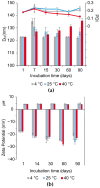NLC-Based Sunscreen Formulations with Optimized Proportion of Encapsulated and Free Filters Exhibit Enhanced UVA and UVB Photoprotection
- PMID: 38543321
- PMCID: PMC10974804
- DOI: 10.3390/pharmaceutics16030427
NLC-Based Sunscreen Formulations with Optimized Proportion of Encapsulated and Free Filters Exhibit Enhanced UVA and UVB Photoprotection
Abstract
The topical use of sunscreens is recommended for avoiding the damaging effects of UV radiation. However, improvements are still needed in the existing products to enhance their photoprotection effectiveness and safety. This involves minimizing the use of chemical UV filters while providing enhanced and prolonged photoprotection. This work investigated novel sunscreen formulations and their UV protection effects by encapsulating Uvinul® A, Tinosorb® S, and Uvinul® T150 into nanostructured lipid carriers (NLCs) based on bacuri butter and raspberry seed oil. First, the impact of critical formulation and process parameters on NLCs' particle size was evaluated using a 22 Face Centered Central Composite Design. Then, formulations were evaluated in terms of critical quality factors, in vitro skin permeation, and in vitro and in vivo photoprotection activities. The developed NLCs-containing formulations exhibited appropriate size (122-135 nm), PdI (<0.3), encapsulation efficiency (>90%), and drug content (>80%), which were preserved for at least 90 days under different stability conditions. Moreover, these NLCs-based formulations had equivalent skin permeation to emulsion-based controls, and the addition of NLCs into sunscreen cream bases in the optimum proportion of 20% (w/w) resulted in enhanced UVA and UVB photoprotection levels, despite a 10% reduction in the total filters content. Altogether, these results describe the application of nanoencapsulated organic UV filters in innovative sunscreen formulations to achieve superior photoprotection and cosmeceutical properties.
Keywords: in vitro photoprotection; in vivo photoprotection; industrial research; nanostructured lipid carrier; skin penetration; sunscreen.
Conflict of interest statement
Margarete M de Araujo has been included as inventors of the patent application number WO2023137532A1 and is currently employed by Aché Laboratorios Farmaceuticos that financially sponsored the study. The company had a role in the design of the study; in the collection, analysis, interpretation of data; in the writing of the manuscript, and in the decision to publish the results. Andressa C. Schneid is currently employed by Aché Laboratorios Farmaceuticos that financially sponsored the study. The company had a role in the design of the study; in the collection, analysis, interpretation of data; in the writing of the manuscript, and in the decision to publish the results. Mariana S. Oliveira has been included as inventors of the patent application number WO2023137532A1. Samuel V. Mussi has been included as inventors of the patent application number WO2023137532A1 and is currently employed by Aché Laboratorios Farmaceuticos that financially sponsored the study. The company had a role in the design of the study; in the collection, analysis, interpretation of data; in the writing of the manuscript, and in the decision to publish the results. Flávia C. Carvalho has been included as inventors of the patent application number WO2023137532A1. Edson A. Bernes Junior is currently employed by Aché Laboratorios Farmaceuticos that financially sponsored the study. The company had a role in the design of the study; in the collection, analysis, interpretation of data; in the writing of the manuscript, and in the decision to publish the results. Renato Faro is currently employed by Ferring Pharmaceuticals that financially sponsored the study. The company had a role in the design of the study; in the collection, analysis, interpretation of data; in the writing of the manuscript, and in the decision to publish the results. Hatylas Azevedo has been included as inventors of the patent application number WO2023137532A1 and is currently employed by Aché Laboratorios Farmaceuticos that financially sponsored the study. The company had a role in the design of the study; in the collection, analysis, interpretation of data; in the writing of the manuscript, and in the decision to publish the results. Mariana S. Oliveira is currently employed in the company Hypera. The company had no role in the design of the study; in the collection, analyses, or interpretation of data; in the writing of the manuscript, or in the decision to publish the results. Flavia C. Carvalho is currently employed in the Universidade Federal de Alfenas. The company had no role in the design of the study; in the collection, analyses, or interpretation of data; in the writing of the manuscript, or in the decision to publish the results. Miller N. de Freitas is currently employed in the company Nintx. The company had no role in the design of the study; in the collection, analyses, or interpretation of data; in the writing of the manuscript, or in the decision to publish the results.
Figures







References
-
- Santos A.C., Marto J., Chá-Chá R., Martins A.M., Pereira-Silva M., Ribeiro H.M., Veiga F. Nanotechnology-Based Sunscreens—A Review. Mater. Today Chem. 2022;23:100709. doi: 10.1016/j.mtchem.2021.100709. - DOI
-
- Puglia C., Damiani E., Offerta A., Rizza L., Tirendi G.G., Tarico M.S., Curreri S., Bonina F., Perrotta R.E. Evaluation of Nanostructured Lipid Carriers (NLC) and Nanoemulsions as Carriers for UV-Filters: Characterization, in Vitro Penetration and Photostability Studies. Eur. J. Pharm. Sci. 2014;51:211–217. doi: 10.1016/j.ejps.2013.09.023. - DOI - PubMed
Grants and funding
LinkOut - more resources
Full Text Sources

